13+ Guided Gratitude Meditation Scripts (+ Yoga Poses)

Meditation is a condition of receptiveness to curiosity in which a man or woman effectively develop refinements of reality rather than discernment.
This article is about gratitude meditation – a unique practice that focuses on acquiring awareness through feelings of gratefulness, and fosters happiness and positivity in our daily lives.
Before you read on, we thought you might like to download our three Mindfulness Exercises for free. These science-based, comprehensive exercises will not only help you cultivate a sense of inner peace throughout your daily life but will also give you the tools to enhance the mindfulness of your clients, students or employees.
This Article Contains:
- What is Gratitude Meditation?
- Meditation and Gratitude
- How Gratitude, Meditation, and Yoga Go Together
- A Look at Gratitude Yoga
- How to Practice Gratitude With Yoga
- Guided Meditation and Gratitude
- 8 Gratitude Meditation Scripts
- 5 Gratitude Mantras
- 5 Yoga Poses for Gratitude
- 3 Yoga Sequences for Gratitude
- A Take-Home Message
- References
What Is Gratitude Meditation?
“Go within every day and find the inner strength; so that the world will not blow your candle out.”
Katherine Dunham.
The simplest form of meditation is breath control, where we focus on our breathing pattern. We consciously notice each inhale and exhale and bring back our awareness to the breath observation the moment we notice it going astray. Research suggests that since our brains are creative and crave for expressing themselves (Kaufman, 2019), giving it the space to cultivate its power and focus on nothing but itself, can calm the raging storms inside.
Gratitude meditation is a conscious effort to appreciate what makes us feel good. It is tied in with opening our hearts and embracing the blessings we have. Many Buddhist monks and nuns actively practice gratitude meditation at the beginning and end of their days to pay tribute to everything that helped them survive that day, including their sufferings (Mindbliss, n.d.).
Gratitude meditation has been there since ages – both in the spiritual and the non-spiritual fields. Unlike conventional meditation practices that need physical arrangements like posture, illumination, or sound adjustments, gratitude meditation is more flexible and can be practiced in a variety of settings for a short or long duration.
Gratitude meditation gives us the power to face our weaknesses and acknowledge the darker sides of life. It guides us to accept them, learn them, and grow with them. And here is what we get from practicing it.
1. We are forever happy
Gratitude meditation brings in feelings of heightened positivity and happiness that lasts forever. The peace that we derive from being grateful in the meditation session gives us the power to realize that happiness does not lie in momentary pleasures and that we cannot be happy if we equate it with mundane gains and profits (Emmons, McCullough, & Tsang, 2003).
Materialism is one of the roots of unhappiness, as many psychologists have suggested, and the only way to not let it overpower us is by practicing and internalizing gratefulness and mindful awareness (Polak & McCullough, 2006). For example, having an ice cream can make you feel good instantly. But when you buy your kid his favorite frozen cup and see him relishing it, isn’t that joy beyond all the material pleasures?
2. We become socially aware
Gratitude meditation improves social relationships and helps in sustaining them for a lifetime. In an evaluative study on the relationship between gratitude and the quality of life, it was found that participants who scored high on gratitude assessments had better social functioning and were great listeners. Besides, gratitude was found to impact all the five traits of the Big Five Theory of Personality.
All participants, no matter what personality traits dominated them, showed an equal amount of satisfaction when they practiced gratitude exercises (Wood, Joseph, & Maltby, 2008).
3. We have better health
As we feel more grateful and content in our daily lives, normal body mechanisms like the sleep-wake cycle improve significantly. Research has indicated that gratitude meditation is directly associated with subjective feelings of better and longer sleep (Wood, Joseph, Lloyd, & Atkins, 2009).
Besides, it also shields us against stress by helping us look into the problems with a calm mind and resolve them efficiently, instead of reacting to them adversely.
Meditation And Gratitude
“The thoughts manifest as the word; The words manifest as the deed; The deeds develop into habits, And habit hardens into character.”
Lord Buddha
Simple meditation practices like mindful breathing or body scan techniques can bring a sense of awareness and freedom.
But, when we add a gratitude adjunct to the meditation practice and mindfulness practice, we create an ambiance of wholesome positivity and strength.
True happiness can be found not by looking at the positive things only, but rather by being aware of the negative things and choosing not to let them affect our wellbeing (Myers & Diener, 1995).
The secret of gratitude practice is that it cultivates the power to reform our thoughts from the very roots of the subconscious mind. Through meditation, the mind melts away the worries, anxieties, insecurities, and all those negative emotions that were clogging it. With a clear unadulterated mind, we can then contemplate on what we are grateful for in life and rejoice the newly discovered self-mastery.
Research on Meditation and Gratitude
Research shows that people who practice gratitude meditation regularly have a well-balanced blood pressure level, better metabolism, and enhanced mood conditions. In a study on suicidal ideations, it was found that higher levels of gratitude were associated with fewer suicidal thoughts and attempts (Kleiman, Adams, Kashdan, & Riskind, 2013).
The reason is simple. By focusing positively on the wrong sides of life, we can change the way we think and feel about them. Studies indicate that gratitude yoga and meditation have significant effects on reducing symptoms of depression, mood disorders, and suicidal thoughts (Stockton, Tucker, Kleiman, & Wingate, 2016).
A recent survey that was conducted on the benefits of gratitude exercises by O’Leary and Dockray in 2015 suggested that individuals who maintain gratitude journals or practice self-reflection are much better at expressing themselves and are more aware of their inner feelings.
Furthermore, the findings also correlated gratitude meditation with higher levels of motivation and a self-driven nature.
How Gratitude, Meditation, and Yoga Go Together
“Happiness will never come to those who fail to appreciate what they already have”
Lord Buddha.
Yoga and meditation are often mentioned in the same line, gratitude being an integral link to both of them. Yoga is the way of life that ‘yogis’ or ancient learned people in the Hindu culture adopted. The ‘yogic’ lifestyle was a combination of healthy eating, healthy exercise, and rigorous learning.
It encouraged coexistence with Nature and followed a here-and-now principle of sustenance. After its adoption in Buddhism, yoga expanded to include meditation, self-control, discipline, and complete awareness of mind and body – the ‘yoga’ that we practice today.
The Influence of Buddhism
Buddha believed that every human birth is worthy of gratitude. By merely thanking our existence, we can feel a lot more empowered and connected to ourselves. Gratitude meditation is the simplest way that we can choose to follow the ‘Dharma’, (the ‘truth’ or the ‘way things are’) in our everyday lives.
Yoga and meditation make gratitude easy to express. For example, in Savasana (The Corpse Pose), when we lie on our back and bring our whole body at a resting position, we cherish the breath we are taking, savor the air on our skin, and feel the stretch in our muscles. Our mind and body pace together that very moment.
All the weariness of the muscles and the stress of life melt away when we lie flat on our back with our eyes closed – and that is gratitude at its peak.
If you haven’t already, start practicing it today and let us know how it changes your life:
A Look at Gratitude Yoga
“Remember to breathe. It is after all, the secret of life”
Gregory Maguire.
Gratitude is the highest level of thought (G.K. Chesterton), and it comes in two ways – by conveying thankfulness to someone or by receiving the same from him/her. Gratitude is far from the scope of constant happiness and ecstasy. Instead, it is the practice of facing the difficulties with an open heart – it lets us accept our problems and guides us to choose a better way of living despite all troubles.
Gratitude exercises can be as simple as writing notes, complimenting ourselves, smiling more at others, appreciating the nature, or making gratitude visits to people whose support changed our lives. We heal by expressing our gratefulness to others – and undoubtedly, yoga is one of the best ways to do so.
There are two ways by which we can express gratitude through yoga.
1. Mudras
Mudras are the yoga gestures we do with our hands. Mudras redirect life energy to the body. It is a gesture of offering that helps to stimulate the different areas of the brain that makes us feel at peace. There are different Mudras that we can practice, each having its exclusive benefits. For some basic information about mudras, take a look at the blog post by yoga enthusiast and wellness coach Kaisa Kapanen (n.d.).
2. Asanas
Asanas are the physical postures that we let the body acquire during a yoga session. We have heard of the word ‘yogasana’ which is nothing but the combination of the two words yoga and asana, and involves practicing different body postures to cultivate feelings of joy, satisfaction, and gratefulness.
Common yoga poses or ‘yogasana’ that can make us feel more thankful include:
- The Child Pose (Balasana),
- The Mountain Pose (Tadasana),
- The Camel Pose (Ustrasana), and
- The Corpse Pose (Savasana).
More on these discussed below.
How to Practice Gratitude With Yoga
Yoga gratitude is all about slowing down, breathing in, and letting us appreciate the present moment and everything that we ‘now’. Through self-love and awareness, yoga gratitude prepares us to express our gratefulness to others.
5 Steps To Express Gratitude Through Yoga
1. Intention
The first step to any gratitude practice is the intention to do it and enjoy the experience. When you sit for a gratitude meditation practice, it is vital that you are aware of what you are doing and why you are doing so. For gratitude meditation and yoga, there should be a firm intention of appreciation and acknowledgment.
2. Commitment
Yoga is another name for self-discipline. Those few minutes on the yoga mat are yours, and you must utilize it fully. Commit to yoga practice to experience all the fantastic things you are capable of doing, and gratitude will flow instantly into yourself and spread over all other areas of your life as well.
3. Make your movements count
Gratitude yoga is goal-directed. It may or may not yield immediate results, but each time you make progress, each posture you acquire, should be an attempt to feel more grateful of your body and thank yourself for giving the time to experience this bliss.
4. Focus
When your intentions are honest, you have committed to ‘yogic’ thankfulness, and you have acquired a pose, the next step will be to focus on yourself and your body. Slowly, you will realize that your mind doesn’t feel perplexed or stressed anymore. You have liberated yourself from the shackles of your negative contemplations and emotional turmoils.
5. Stay grounded
When we are grounded, we are more appreciative and less self-defeating. An excellent way to incorporate grounding in gratitude yoga is to start and end the session with breath control or muscle relaxation. Breath control allows us to tune into ourselves and question the beliefs that make us suffer.
Tiffany Cruikshank, a leading yoga trainer and a specialist in oriental yoga medicine for sports and orthopedics, says that Sukhasana, a simple cross-legged sitting posture is vital for deriving gratefulness through yoga.
Guided Meditation and Gratitude
“The quieter you become, the more you can hear”
Baba Ram Dass.
Guided meditation is performed under the supervision of a narrator who takes us through the different stages of inculcating gratitude. Thanks to the concept of neuroplasticity, we now know why guided meditation is the best for practicing gratitude.
Neuroplasticity explains that the brain has the power to shape and reshape itself according to our thoughts, feelings, and environment (Costandi, 2016). It suggests that the mind is unable to differentiate between real events and imagination. For example, in guided meditation, when the instructor asks us to imagine something good, the brain takes it to be a real experience, and forms neural networks making us feel the real emotions associated with the imagery.
By changing the way our brain works, guided meditation has the power to alter our psychological functioning. The narrations can activate our muscles, change our biological functioning, and improve the way we combat stress. Guided meditation reprograms the mind by accessing the subconscious and the unconscious layers and resolving the underlying conflicts that we might not have been consciously aware of.
How To Start A Guided Gratitude Meditation
Tara Brach, the founder and mentor of the Insight Meditation Community Of Washington (n.d.), described that, beginning and successfully participating in guided gratitude meditation has four basic requirements:
- Daily practice – Consistency is vital for any meditation. To explore and enjoy the full benefits of guided meditation practice, it is vital that we commit to daily practice.
- Location and time – The brain works in strange ways. If we choose a particular time and place for practicing guided meditation every day, chances are better that we will benefit from it more. Most practitioners recommend using a comfortable spot for meditation practice that is free from excess light, sound, or physical distractions.
- The right posture – The ideal guided meditation posture is a comfortable sitting position with the neck extended and the back straight. The proper stance allows smooth blood circulation and breathing. A tired body may tend to slouch the back or fold the legs, but it is vital that we correct the posture every time it goes wrong.
- Zero judgment – The first time may be a complete failure. But we must not let it overrule our commitment to daily practice. The mind may wander, get distracted, or get disappointed by the underachievements, but our goal is to prevent this frustration and look beyond the temporary obstacles.
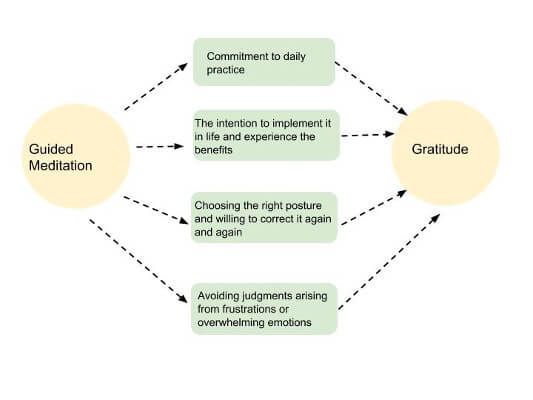
7 Gratitude Meditation Scripts
“Meditation means dissolving the invisible walls that unawareness has built”
Sadhguru.
1. Guiding light gratitude meditation
Guiding light is an online blog that focuses on meditation training and awareness. The guided gratitude meditation script that they follow is based on one of the retreats of famous meditation mentors. The gratitude meditation gently guides the follower through a serene path of inner peace and wisdom.
Starting from expressing gratitude to our breaths, heartbeat, the five senses, and finally, to the people we love, this meditation awakens our consciousness in the gentlest way possible, leaving us refreshed and emotionally satisfied from inside. You can listen to the audio script of this meditation or follow the written format and practice it yourself.
2. Change to chill gratitude meditation script
Change to chill is a web-based organization that helps people, including children and adolescents, to beat stress and develop emotional resilience. Out of their numerous self-help resources of mindfulness and meditation, the gratitude meditation script is worth mentioning.
It is an emotion-focused practice, and, like most gratitude meditation practices, begins with breath control. Once the follower is immersed into the process, the narrator slowly progresses toward shifting the focus to our innermost emotions of love, affection, care, and empathy. It lets us confront our positive energy and express gratitude to ourselves and others.
You can have a closer look at this meditation script and incorporate it as a part of your daily gratitude practice.
3. Gratitude Meditation by Flourish Yoga
Krista, the founder and mentor of Flourish yoga, dedicated her Canada-based organization to promote awareness for a healthy lifestyle. Her blogs and training manuals contain all the know-how of proper diet, active lifestyle, yoga, and meditation.
The gratitude meditation script that she has developed is relaxing and can be practiced during any time of the day. It is flexible, nourishing, and awakens our bodily senses instantly, making us more mindful of the present. The full audio script, with description, is available on her website.
4. Mind-Body Balance Guided Gratitude
Linda Hall, an audio trainer and a well-known meditation coach of the Mind-Body Balance meditation training institute, created this guided gratitude meditation that helps in beating stress, insomnia, and building emotional resilience. You can follow her script for experiencing pure appreciation and self-reflection at:
5. Gratitude and Mindfulness Meditation
The Mindfulness Gratitude Meditation is a free exercise posted by Mindfulness Exercises, a site that is dedicated to providing valuable mindfulness and meditation resources for professionals of all levels. You can follow their script here.
6. Morning gratitude meditation
Josie Robinson, the author of the book ‘Gratitude Jar: A Simple Guide To Creating Miracles’ is a wellness counselor who believes anything can be achieved if we are grateful from the inside. She suggests that the best way to start a day is by expressing gratitude to everything that helped us sustain yesterday and gives us the hope of living today.
Her gratitude meditation is inspirational and requires only five minutes in the morning before we start our day. You can watch, practice, and enjoy the process here:
7. Guided gratitude meditation for wealth
This meditation was published as a part of one of the 21-day mindfulness program developed by Bob Baker. It is a morning practice and, as the author suggests, attracts wealth and happiness towards you. Follow the meditation here:
5 Gratitude Mantras
“What you seek is seeking you”
Rumi.
A ‘Mantra’ is a cluster of powerful words with a deep meaning that can enlighten the mind. We speak or chant them with noble intentions and complete dedication. Mantras are the heart of many Buddhist meditation practices, especially the ones focusing on gratitude. Using mantras can help us to:
- Accept and embrace gratitude
- Invite positive energies around us and reflecting the same
- Attract happiness and contentment
By merely listening to these mantras being chanted or saying them ourselves and internalizing their meanings, we can feel more aware of our senses and be thankful for what this moment has to offer to us. Let us have a look at five such Sanskrit mantras that enhance gratitude and should be an essential component of our daily gratitude meditation.
Sanskrit Mantras For Gratitude And What They Mean
Matt Caron, a dedicated yoga practitioner, and mentor, described some Sanskrit mantras for gratitude meditation. These mantras, as he mentioned in his article, are powerful enough to dissolve any resistance to gratitude in our minds, and should be an essential part of all gratitude meditation exercises.
1. Namaste – I greet every soul that I meet
Many yoga and meditation sessions begin and end with this mantra. By expressing our acknowledgment to ourselves in this mantra, we let way for universal acceptance and forgiving. This one word has the power of teaching the mind that there is goodness in ourselves and everyone around us, and greeting them with positive energy is what this mantra is all about.
2. Dhanyavad – I thank you
Dhanyavad is a direct expression of gratitude. In gratitude meditation, we can repeat this mantra each time we thank ourselves or others. We can convey our thankfulness to the people who love us, to this life that we are living, and to the Almighty for showering His blessings on us. This simple gratitude mantra can address every little or big thing that deserves our gratitude.
3. Kritajna Hum – I am grateful
This mantra spreads self-awareness and allows us to accept that we are thankful. It lets us connect with the profound energies of the Universe and for a moment, take pride in the fact that we do have so much around us to be thankful for. In gratitude meditations, we can take short pauses to chant this mantra and internalize its meaning entirely.
4. Karuna Hum – I am kind and compassionate
The word ‘Hum’ in Sanskrit (and Pali) means ‘I’ or ‘Me’, and ‘Karuna’ implies kindness and affection. This gratitude mantra is a powerful self-regulation and self-awareness tool that opens our mind to embrace the fact that we are kind, loving, and considerate.
It lets us realize our virtues and see kindness in the self and others. By repeating this mantra, we choose to see the love that we have for others and the affection others have for us and be thankful for the peace and happiness that these beautiful feelings have given us.
5. Prani Dhana – My soul is my asset
‘Dhana’ means riches, and ‘Prani’ is an adaptation of the word ‘Pran’ or ‘Life’. This gratitude mantra reminds us of the real riches of life – our mind and our body. It tells us that the first thing that we should be grateful for is our body whose normal functioning allows us to experience everything good and bad – without the heartbeat, the blood flow, and the regular bodily functions; we are nothing but lifeless entities.
With this positive acknowledgment, we can start looking at life from a broader perspective.
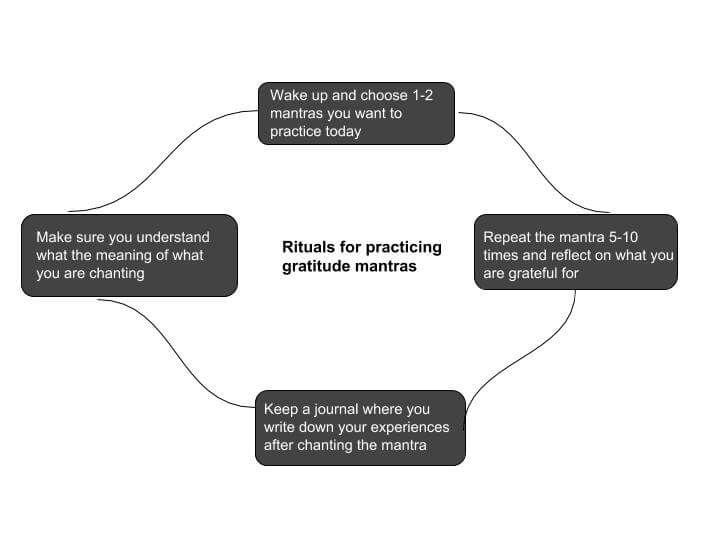
5 Yoga Poses For Gratitude
Try our these recommended yoga posses.
1. Savasana – The Corpse Pose
Objective
Thanking your body for all the efforts it has made so far. This usually is the final resting position that we practice at the end of a yoga session.
Practice
- Lie down on your back with arms by the side and heels touching the ground
- Turn your palms to face the ceiling and come to a complete resting position
- Breathe in and breathe out deeply. Devour all the air that you can with each breath in and leave all the air you can with each breath out
- Close your eyes and rest for a few minutes
- Get up with a long stretch or a big hug to yourself (arms embracing your knees in a lying position), and exhale with a deep ‘ahh’ sound with the intention to release all the pent up stress from your inside.
2. Bhujangasana – The Cobra Pose
Objective
To open ourselves and breathe fully, thereby, filling the mind and the body with pure gratitude. It is rejuvenating and can be done incorporated in any yoga sequence.
Practice
- Start with two deep breaths and lie down on your belly
- Slowly, raise your body with full support on your arms and bend your elbows
- Slowly start stretching your arms as you raise your chest to the ceiling and be very mindful of how your body feels about it
- Roll your shoulders back and look above. Your hands are bend and supporting your posture, your legs are aligned to the center of the mat, and your toes are touching the ground
- Bend your back just as much as you can. Never force or rush yourself. Your sole intention here is to feel your body and sprinkle feelings of gratitude from head to toe
- Keep breathing till you are in the cobra position and release the pose with a deep sigh of relief. Come to a resting place with your chin touching the mat and hands by your side.
3. Anjaneyasana – The Low Lunge
Objective
To find gratitude in yourself and take a moment to appreciate your talents.
Practice
- Start with a comfortable standing position and step your right foot in front
- Lower your left foot down as much as you can and bend your right knee to your limit
- Raise your chest and look up to the ceiling. Stretch your arms back to your chest and your palms exposed
- Breathe in and out and feel the stretch. Stay there for a few moments and appreciate yourself for your efforts
- Release with a deep exhale and repeat the same with your left foot in front
4. Ustrasana – The Camel Pose
Objective
This pose inspires us to summon resilience as we face a difficult situation in life. The challenges we face while practicing this reminds us of our courage and how it helped us to overcome adversities in life.
Practice
- Fold your knees and sit with your back straight
- Keeping your back straight and knees folded back, start standing up on the ground, just as much as you can
- Reach up until you feel your chest, abdomen, heels, and shoulder muscles getting stretched
- Now, start stretching your hands back to touch the heels and keep looking straight
- Tilt your head back slightly and take a few deep breaths before you release the pose
5. Tadasana – The Mountain Pose
Objective
This is a relaxing pose that we can practice alone or as a part of a gratitude yoga sequence. It lets the positive energy enter our body and instill hope into our hearts – a great way to express gratitude to our dreams that motivate us to keep trying.
Practice
- Come to a comfortable standing position with your back straight and your neck extended
- Keep your gaze static and take a moment to thank your life for everything it has given you so far
- Slowly start moving your legs apart until they are aligned with your hips
- Look forward and raise your chin as much as you can. Feel the stretch in your back, your shoulders, and your inner thighs. You can extend your arms to the ceiling like an embracing gesture and bring a smile on your face
- Notice how you feel and come back to rest.
4 Yoga Sequences for Gratitude
“Yoga is not about touching the toes. It is about what you learn on the way down”
Jigar Gor.
Creating a yoga sequence for building and sustaining gratitude is primarily a matter of intentions. Leigh Weingus, in her article on yoga and gratitude, mentioned that there are four essential aspects of a gratitude yoga sequence:
- We must not expect outcomes of the yoga session
- We should choose poses that we haven’t tried before and challenge ourselves each day
- We can use mantras throughout the session or at regular intervals to get a deeper insight
- We should be flexible to try new things and change our patterns anytime.
Courses of gratitude yoga may be different for each one us, depending on our physical strength, mood, and other external factors. Here are some accessible yoga sequences that we can follow and include in our gratitude sessions regularly.
1. Gratitude Yoga Sequence by Francesca Bove
Francesca Bove talked about this yoga sequence in her post on Sonima, an online meditation blog. Her process is simple and focus on suitable asanas that should be followed in the order she has mentioned. The stances include mountain pose, by side stretches, different variations of the lunge pose, warrior positions, and finally savasana as the ending supplement.
This sequence is a blend of poses of varying levels of difficulty and can be practiced by anyone who does yoga daily. Learn more about this sequence from her article here.
2. Yin Yoga Sequence For Gratitude
Yin Yoga is an advanced branch of yoga which is slow-paced and aims at increasing muscle strength and flexibility. With its deep-rooted connections in China, India, and North America, Yin practices are now popularly preached everywhere.
An ideal Yin Yoga for gratitude includes poses and mudras like – reclined butterfly, pigeon pose, hero pose, and warrior positions with intermittent sessions of relaxation in between. An ideal sequence was mentioned by Nancy Nelson in her blog, where she has described all the poses with their correct order and durations. The goal is to make us more mindful, kind, and thankful for the present.
3. Flow Yoga Sequence For Gratitude
Flow yoga or ‘Vinyasa’ is a popular yoga practice for enhancing strength and happiness. A flow sequence that promotes gratitude was mentioned by Ivonne Ackerman, a New York based yoga and wellness practitioner.
The sequence starts from cognitive reformation, as Ivonne believes any change in the world begins with a thought. Her practice blends thought restructuring and physical activities that promote gratitude, and can be useful for beginners attempting yoga for the first time.
A Take-Home Message
“You yourself, as much as anybody else in this entire Universe, deserve your love and affection”
Buddha.
Commitment to gratitude meditation and yoga means the commitment to invest in ourselves – in our mind, our body, and our dreams. Practicing gratitude meditation won’t save us from the pain and sufferings, or guarantee 24/7 happiness, but it will, for sure, gift us the power to accept constraints, and as Albert Einstein has put it:
“Once we accept our limits, we go beyond them.”
We hope you enjoyed reading this article. Don’t forget to download our three Mindfulness Exercises for free.
- Brach, T. (n.d.). How to meditate. Retrieved from https://www.tarabrach.com/wp-content/uploads/pdf/HowToMeditateForPDF.pdf
- Costandi, M. (2016). Neuriplasticity. Cambridge, MA: MIT Press.
- Emmons, R. A., McCullough, M. E., & Tsang, J.A. (2003). The assessment of gratitude. In S. J. Lopez & C. R. Snyder (Eds.), Positive psychological assessment: A handbook of models and measures (pp. 327–341). Washington, DC: American Psychological Association.
- Kapanen, K. (n.d.). 7 Common yoga mudras explained. Do You. Retrieved from https://www.doyou.com/7-common-yoga-mudras-explained-23667/
- Kaufman, S. B. (2019, January 4). The neuroscience of creativity: A Q&A with Anna Abraham. Scientific American. Retrieved from https://blogs.scientificamerican.com/beautiful-minds/the-neuroscience-of-creativity-a-q-a-with-anna-abraham/
- Kleiman, E. M., Adams, L. M., Kashdan, T. B., & Riskind, J. H. (2013). Gratitude and grit indirectly reduce risk of suicidal ideations by enhancing meaning in life: Evidence for a mediated moderation model. Journal of Research in Personality, 47(5), 539-546.
- Mindbliss. (n.d.). Gratitude meditation: Mastering the art of being intentionally thankful. Retrieved from https://mindbliss.com/gratitude-meditation/
- Myers, D. G., & Diener, E. (1995). Who is happy? Psychological Science, 6(1), 10-19.
- O’Leary, K., & Dockray, S. (2015). The effects of two novel gratitude and mindfulness interventions on well-being. The Journal of Alternative and Complementary Medicine, 21(4), 243-245.
- Polak, E. L., & McCullough, M. E. (2006). Is gratitude an alternative to materialism? Journal of Happiness Studies, 7(3), 343-360.
- Stockton, J. G., Tucker, R. P., Kleiman, E. M., & Wingate, L. R. (2016). How does gratitude affect the relationship between positive humor styles and suicide-related outcomes? Personality and Individual Differences, 102, 240-244.
- Wood, A. M., Joseph, S., Lloyd, J., & Atkins, S. (2009). Gratitude influences sleep through the mechanism of pre-sleep cognitions. Journal of Psychosomatic Research, 66(1), 43-48.
- Wood, A. M., Joseph, S., & Maltby, J. (2008). Gratitude uniquely predicts satisfaction with life: Incremental validity above the domains and facets of the five factor model. Personality and Individual Differences, 45(1), 49-54.
Let us know your thoughts
Read other articles by their category
- Body & Brain (49)
- Coaching & Application (57)
- Compassion (26)
- Counseling (51)
- Emotional Intelligence (24)
- Gratitude (18)
- Grief & Bereavement (21)
- Happiness & SWB (40)
- Meaning & Values (26)
- Meditation (20)
- Mindfulness (45)
- Motivation & Goals (45)
- Optimism & Mindset (34)
- Positive CBT (28)
- Positive Communication (20)
- Positive Education (47)
- Positive Emotions (32)
- Positive Leadership (18)
- Positive Parenting (4)
- Positive Psychology (33)
- Positive Workplace (37)
- Productivity (16)
- Relationships (46)
- Resilience & Coping (36)
- Self Awareness (21)
- Self Esteem (38)
- Strengths & Virtues (32)
- Stress & Burnout Prevention (34)
- Theory & Books (46)
- Therapy Exercises (37)
- Types of Therapy (64)
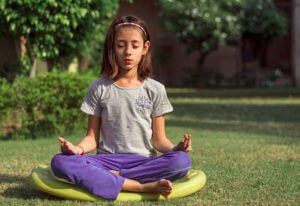
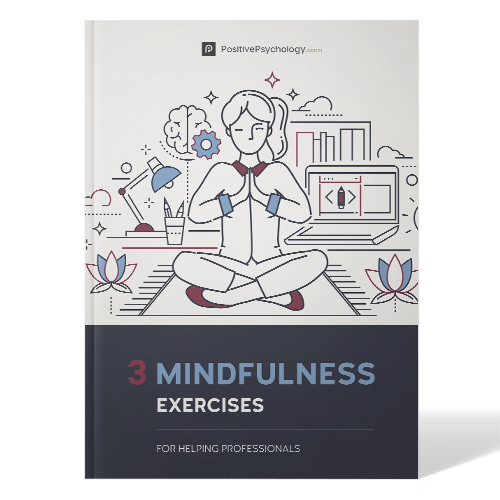
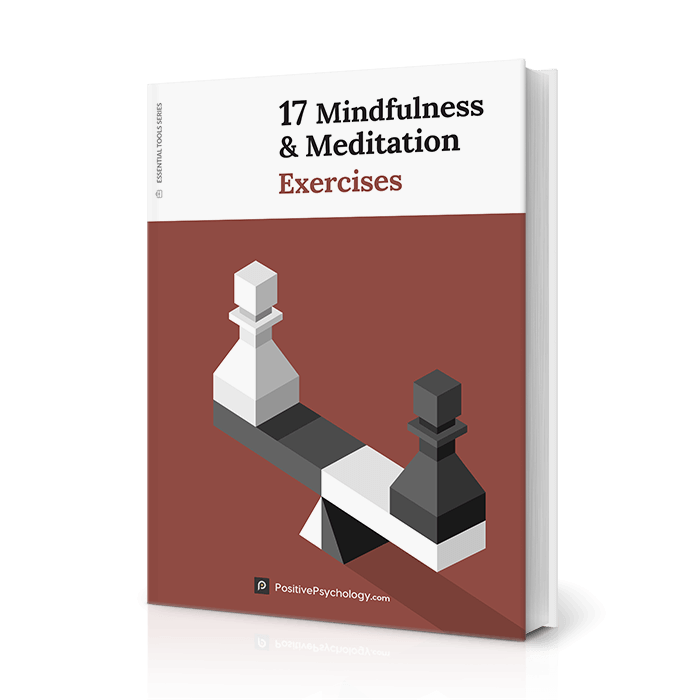


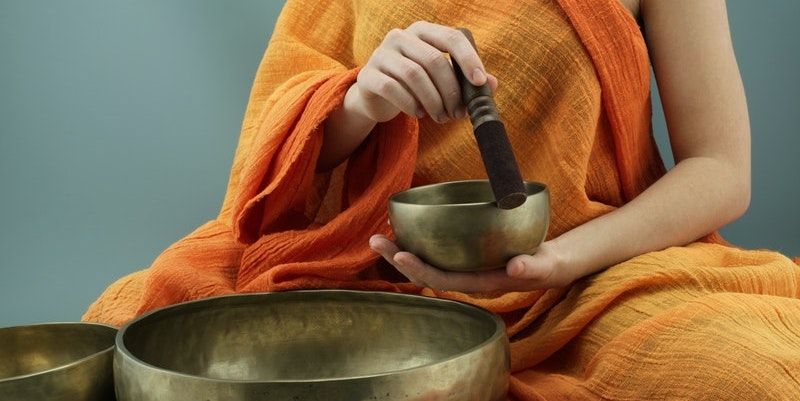
What our readers think
Madhuleena, looking for articjes about self counseling, yours is number one in my list, I use, The Course in Micacles by Helen Schulman, The power of Now by Eckhart Tolle and The Angels within us by Joseph Randolph Price. Your information adds to my collection of profound tools to continue my spiritual development. Thank You.
Help full Information
Thank-you, very inspirational article and useful quotations to end my yoga teaching classes. I will also be introducing my students to ‘gratitude yoga and meditation concepts and asana
Amazing wealth and range of information. Thank you for all the resources and links. Great read!
Thank you! You may have just given me a solution to healing a toxic relationship. Thank you once again.
Madhuleena, thank you. An interesting and very informative article to guide my teaching.
I agree with your details , excellent post.
Dear sir/madam
very wonderful informative information .I am happy for the easiest ways information to public
ManyThanks, for this comprehensive and well-researched article on Gratitude and the overall effect every facet of our lives. 😉 I look to incorporate some of what you have shared in my life and the lives of my clients.
Gratitude and appreciation form heart to heart